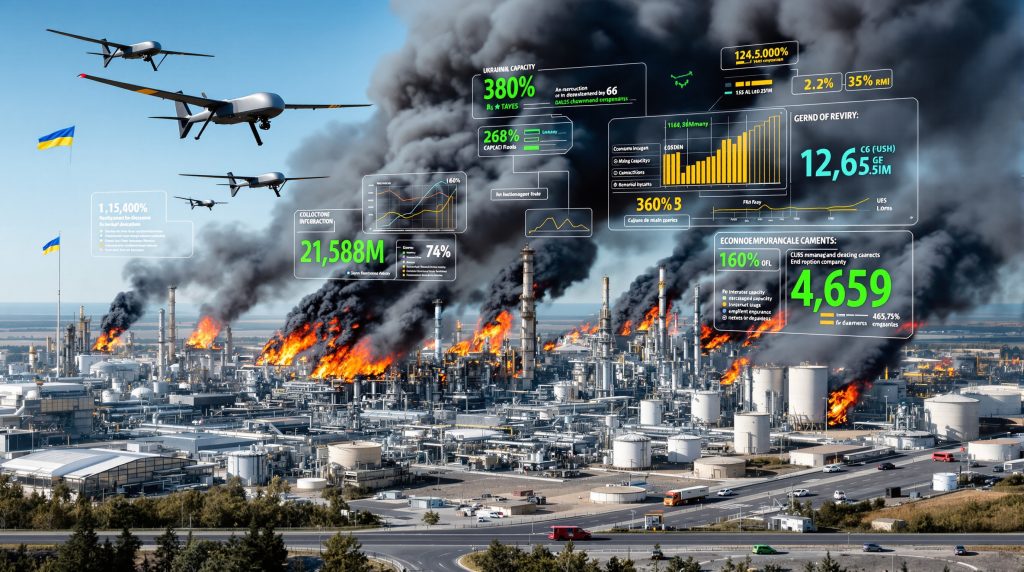## Understanding Strategic Energy Infrastructure Attacks
The Ukrainian drone strike on Volgograd refinery marks a pivotal moment in modern conflict. This operation, taking place in November 2025, illustrates how precision targeting of economic assets is as important as conventional military objectives. Furthermore, this event highlights the strategic use of unmanned systems supported by advanced technology.
Modern conflict increasingly centres on economic disruption rather than solely territorial conquest. The targeting of Russia's refining infrastructure goes beyond immediate military gains. It reduces state revenue, creates domestic supply shortages, and visibly exposes vulnerabilities in systems once thought to be secure. For instance, recent discussions on oil price movements reveal how economic pressure can reshape markets.
## What Makes Volgograd Refinery a Critical Strategic Target?
### Russia's Refining Infrastructure Vulnerabilities
The Lukoil-operated Volgograd facility processes approximately 13.7 million tons annually – about 5% of Russia's total refining throughput. Its critical role in domestic fuel distribution, especially across southern and central oblasts, ensures its significance. In addition, it has major export capabilities through Black Sea terminals.
The refinery’s position on the Volga River provides access to essential transport corridors. The CDU-5 unit, processing nearly 66,700 barrels per day, acts as the operational heart of the complex. Consequently, these vulnerabilities impact not only local supply lines but also ripple into global markets.
### Economic Impact Assessment
Key Operational Statistics:
- Regional fuel supply: Serves multiple southern and central Russian oblasts.
- Export infrastructure: Provides direct access to Black Sea shipping terminals.
- Transportation networks: Connects via the Volga River and rail systems.
- Strategic importance: Acts as a crucial domestic supply chain node.
The disruption of the refinery creates extensive cascading effects. Increased operational costs, higher insurance premiums, and additional security expenditures inevitably follow. Moreover, the resulting energy security trends have raised concerns about future vulnerabilities.
## How Ukrainian Long-Range Strike Capabilities Enable Deep Territory Operations
### Advanced Drone System Evolution
Ukrainian forces have vastly improved their long-range capabilities by combining commercial drone components with military-grade modifications. These cost-effective, precision platforms rely on GPS and GLONASS navigation, ensuring real-time targeting and coordinated multi-unit deployment. Furthermore, their adoption of such systems underlines a significant evolution in modern warfare.
Key technical attributes include:
- An operational range exceeding 1,000 kilometres.
- Real-time video guidance for pinpoint accuracy.
- Swarm coordination to overwhelm enemy air defences.
- Weather-resistant operations in diverse climates.
- Affordable manufacturing using off-the-shelf components.
### Operational Deployment Strategies
Ukrainian tactics involve sophisticated coordination aimed at maximising strike impact while minimising detection risks. Multiple drone deployments create a complex targeting picture that challenges traditional air defence systems. For instance, when faced with conventional aircraft threats, these unmanned systems have proven remarkably effective.
During the November 2025 operation, coordinated strikes were deployed across multiple regional targets. This distributed approach not only complicates defensive measures but also broadens the overall operational impact.
## Immediate Operational Consequences of the Volgograd Attack
### Facility Damage and Production Impact
The attack on November 6 resulted in severe damage that forced a complete operational shutdown. Fires in the main crude distillation unit and hydrocracker meant operations were halted pending further verification. Analysts note that the Ukrainian drone strike on Volgograd refinery has intensified discussions on energy vulnerability.
Verified Impact Assessment:
| Infrastructure Component | Damage Status | Operational Effect |
|---|---|---|
| CDU-5 Primary Unit | Fire damage confirmed | Complete shutdown required |
| Hydrocracker Systems | Affected by strikes | Operational suspension |
| Emergency Response | Ongoing containment | Extended repair timeline |
| Regional Distribution | Supply chain disruption | Alternative routing required |
The damage not only affects production but also ripples into wider economic spheres. The local communities and regional industries face severe challenges, including increased security and higher repair costs.
### Human and Regional Consequences
The incident led to one confirmed fatality and multiple injuries from falling debris. Additionally, reports confirm that 13 airports were temporarily closed amid the broader attack wave. As a result, emergency services have been stretched to their limits while repair operations continue under heightened security.
Coordinated firefighting responses have been necessary to contain fires at fuel storage sites. These efforts further stress the already disrupted supply routes, exacerbating regional instability.
## Why Energy Infrastructure Has Become Central to Modern Warfare
### Economic Warfare Principles
Targeting energy infrastructure achieves several strategic objectives. Ukrainian officials claim that persistent strikes have reduced national output by about 17% during 2025. This economic pressure forces adversaries to divert resources and adjust policy priorities.
Strategic objectives include:
- Revenue disruption: Weakening state financing for military operations.
- Domestic impact: Creating fuel shortages for civilian markets.
- Supply chain vulnerability: Mandating expensive security upgrades.
- Economic pressure: Elevating operational costs on multiple fronts.
Economic warfare not only disrupts the enemy’s fiscal balance but forces broader shifts in government strategy.
### Psychological and Political Impact
Attacks on infrastructure send a powerful psychological message. They challenge the long-held belief that such assets are impregnable, affecting both civilian morale and political stability. Consequently, visible vulnerabilities may undermine the legitimacy of government promises.
Such strategies have redefined modern warfare, where economic disruption is now as critical as military engagement.
## Russia's Refining Sector Adaptation to Sustained Operations
### Enhanced Security and Defensive Measures
In response to continual targeting, Russian authorities have bolstered security across key energy facilities. Measures enacted include increased air defences, advanced electronic warfare systems, and comprehensive emergency protocols. In addition, this restructuring highlights the importance of investing in energy transition challenges.
Security Enhancement Programs:
- Deployment of robust air defence systems.
- Installation of electronic counter-countermeasures.
- Regular personnel training and updated protocols.
- Expanded emergency response coordination.
- Infrastructure upgrades to withstand drone attacks.
These measures not only aim to protect assets but also to ensure continuity of operations under duress.
### Operational Adjustment Strategies
The refining sector has adopted distributed processing and activated backup facilities to mitigate disruptions. This strategic reserve utilisation ensures a continued domestic fuel supply despite periodic production halts. However, increased repair and security costs have led to re-evaluations of operational efficiency.
Such adaptations are complemented by alternative routing and supply chain diversification strategies, underscoring the dynamic nature of modern conflict.
## International Sanctions Impact on Recovery Capabilities
### Equipment and Technology Access Restrictions
Recent US sanctions have further complicated rapid recovery efforts for Russian refineries. Lukoil’s access to components, such as advanced monitoring systems, is now restricted. Consequently, the sanctions have imposed long-term challenges in maintaining operational efficiency. These measures also mirror concerns raised within the US economy and tariffs framework.
Sanctioned Categories Include:
- Imports of critical refinery components from the West.
- Advanced digital monitoring and control systems.
- Specialised repair and maintenance equipment.
- International financial services essential for investments.
Such constraints force companies to seek alternative suppliers, often at increased cost and reduced efficiency.
### Global Asset Divestiture Requirements
Under the new sanctions regime, Lukoil is compelled to divest numerous international holdings. This move significantly reduces its operational footprint in Europe and Africa. In addition, the resulting loss of international expertise further complicates restoration strategies.
These forced asset sales not only diminish revenue but also limit access to crucial financial and technological resources.
## Global Energy Market Responses and Implications
### Price Volatility and Market Reactions
Strikes on Russian refining capacity have increased price volatility in global energy markets. For instance, industry reports indicate that reduced Russian output has led to an increment in Brent crude prices. Furthermore, changes in market dynamics have produced temporary product premium spikes, as well as adjustments in insurance rates.
Market Impact Indicators:
- Rising Brent crude prices after significant strikes.
- Increased regional product premiums.
- Adjustments to insurance rates for affected facilities.
- Heightened demand for alternatives to Russian refined products.
Consequently, these shifts have prompted a broader reassessment of global supply chains.
### Supply Chain Adaptation Strategies
International markets are rapidly diversifying their supply chains away from Russian sources. Energy companies now prioritise route development and reserve releases to maintain energy stability. In addition, strategic investments in non-Russian production are on the rise, increasing overall market resilience.
Companies are also focusing on:
- Diversifying supply sources.
- Enhancing infrastructure development in stable regions.
- Strengthening strategic reserve policies.
Such adaptations are vital to counterbalance geopolitical uncertainties.
A detailed report on energy sector strike events provides further insights into these market responses.
## Long-Term Strategic Implications for Modern Conflict
### Evolution of Asymmetric Warfare Capabilities
The success of Ukrainian drone operations demonstrates how smaller nations can leverage advanced technology to challenge larger adversaries. The clear integration of commercial innovation with military strategies underlines the transformation in modern conflict. In addition, emerging critical defense materials show increasing global relevance.
Emerging Warfare Trends:
- Enhanced deep-strike capabilities by smaller nations.
- Prioritisation of economic targets alongside traditional military assets.
- Exploitation of infrastructure vulnerabilities for strategic leverage.
- Democratization of advanced military technology.
These trends suggest a redefinition of power projection and traditional deterrence models.
### Deterrence and Defense Paradigm Changes
Conventional air defence systems now struggle against coordinated drone swarm attacks. This reality necessitates new, distributed security strategies instead of relying solely on centralised perimeters. Furthermore, economic resilience has emerged as a national security priority. Countries now reassess critical vulnerabilities in supply chains and energy reserves.
Multi-domain coordination between military and economic sectors is now emerging. Consequently, this approach forces national and international defence planners to adjust existing doctrines.
## Future Conflict Integration of Economic Warfare Tactics
### Technological Proliferation and Development
The demonstrated effectiveness of recent operations is driving accelerated efforts in unmanned systems development. Nations are increasing investments in swarm coordination, electronic warfare countermeasures, and autonomous targeting technologies. In addition, continued research into critical defense materials is prompting technology reforms worldwide.
Development Priorities Include:
- Enhancing advanced UAV systems.
- Improving swarm coordination and communications.
- Evolving electronic warfare countermeasures.
- Advancing autonomous targeting capabilities.
- Innovating cost-effective precision strike platforms.
### Military Planning Evolution
Global defence planners now incorporate economic target prioritisation into strategic designs. Comprehensive vulnerability assessments of dual-use facilities are critical for modern conflict management. In addition, military and economic coordination has become essential for developing resilient homeland defence strategies.
Historical analysis shows that the Ukrainian drone strike on Volgograd refinery remains a key turning point. Such events have forced military doctrines to evolve in response to combined economic and technological warfare.
## Transforming Conflict Parameters Through Technological Innovation
The Ukrainian drone strike on Volgograd refinery exemplifies how technological advancement reshapes conflict. This operation has redefined strategic priorities by integrating economic disruption with traditional military objectives. Moreover, history will remember that the Ukrainian drone strike on Volgograd refinery accelerated debates on infrastructure vulnerability.
In conclusion, the Ukrainian drone strike on Volgograd refinery reinforced modern strategic imperatives. As nations recalibrate policies and invest in resilient energy systems, the interplay of economic warfare, advanced drone technology, and international sanctions will continue influencing global security for years to come.
Seeking Opportunities in Energy Security and Critical Materials Investments?
Discovery Alert's proprietary Discovery IQ model delivers real-time alerts on significant ASX mineral discoveries in critical materials and energy security sectors, empowering subscribers to identify actionable opportunities as geopolitical tensions reshape global supply chains. Begin your 30-day free trial today at Discovery Alert to position yourself ahead of market movements driven by strategic resource demands.




